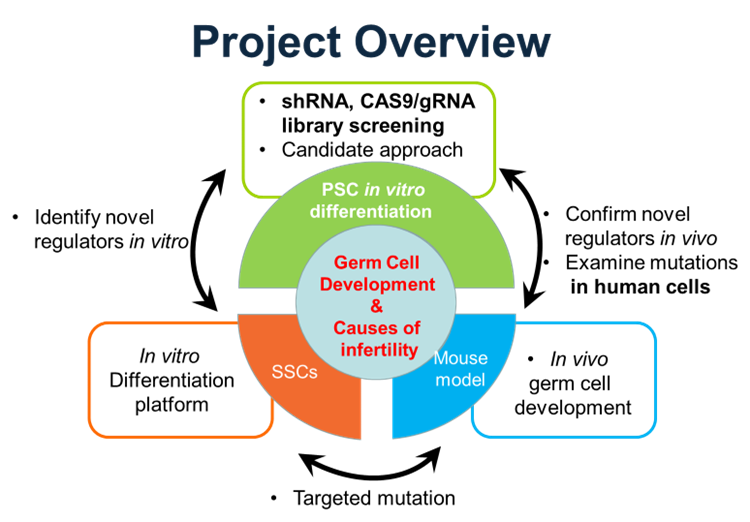Yuan Wang, PhD
Education/Training Information
- Bachelor of Medicine, Shandong Medical University, China
- M.S., Chinese Academy pf Preventive Medicine, China
- PhD, Boston University, USA
- Postdoc, Harvard Medical School and NIEHS
Research Interests
The initial germ cell population, known as primordial germ cells (PGCs), arises from proximal epiblast around embryonic day 7 in mice. These PGCs subsequently migrate to the genital ridge. In male, PGCs become prospermatogonia and eventually develop into sperm after birth. Disrupting this process causes male infertility. My main research focus is to dissect the regulatory programs that govern mammalian germ cell development. Specifically, I am interested in understanding how PGCs diverge from somatic lineages to establish germline competency in embryos, and how developmental cues and metabolic needs are intertwined at mitochondria to regulate spermatogonial fate decision to become sperm after birth. Empowered with in vitro differentiation platforms of pluripotent stem cells and spermatogonial stem cells, as well as in vivo genetically modified mouse models, my laboratory aims to improve our knowledge in mammalian reproduction, thereby informing the underlying genetic causes of human male infertility.

Selected Publications
- Zhang Z, Miao J, Wang H, Ali I, Nguyen D, Chen W, Wang Y*. (2024) Accelerated mitochondrial dynamics are required for spermatogonial differentiation. Stem Cell Reports. In press
- Miao J, Wang C, Wang Yo, Chen W, Kakasani S, & Wang Y*. (2024) GASZ self-interaction clusters mitochondria into the intermitochondrial cement for proper germ cell development. PNAS Nexus, 3 (1): pgad480.
- Wang P, Su J, Wang J, Xie Y, Chen W, Zhong J, & Wang Y*. (2024) NRF1 promotes primordial germ cell development, proliferation and survival. Cell Proliferation. 57(1): e13533.
- Wang M, Liu Y, Wang Z, Qiao L, Ma X, Hu L, Kong D, Wang Y, Ye H. An optogenetic-controlled cell reprogramming system for driving cell fate and light-responsive chimeric mice. Adv Science. 2023; 10 (4): 2202858.
- Dong L, Sun Q, Zhu Z, Wang C, Ye S, Li Z, Wang Y*. Xenotransplantation of spermatogonia-like cells derived from human pluripotent stem cells in immune-competent mouse testes. Front Cell Dev Biol. Epub on May 23, 2022.
- Miao J, Chen W, Wang P, Zhang X, Wang L, Wang S, Wang Y*. MFN1 and MFN2 Are Dispensable for Sperm Development and Functions in Mice. Int J Mol Sci. 2021;22 (24): 13507.
- Wang S, Qiao H, Wang P, Wang Y*, Qin D. ZDHHC19 Is Dispensable for Spermatogenesis, but Is Essential for Sperm Functions in Mice. Int J Mol Sci. 2021;22 (16): 8894.
- Huang X, Chao R, Zhang Y, Wang P, Gong X, Liang D, Wang Y*. CAP1, a target of miR-144/451, negatively regulates erythroid differentiation and enucleation. J Cell Mol Med. 2021;25 (5):2377-89.
- Chen W, Zhang Z, Chang C, Yang Z, Wang P, Fu H, Wei X, Chen E, Tan S, Huang W, Sun L, Ni T, Yang Y, Wang Y*. A bioenergetic shift is required for spermatogonial differentiation. Cell Discov. 2020;6:56.
- Chen W, Sun Y, Sun Q, Zhang J, Jiang M, Chang C, Huang X, Wang C, Wang P, Zhang Z, Chen X, Wang Y*.MFN2 Plays a Distinct Role from MFN1 in Regulating Spermatogonial Differentiation. Stem Cell Reports. 2020;14 (5):803-17.
- Zhao Y, Ye S, Liang D, Wang P, Fu J, Ma Q, Kong R, Shi L, Gong X, Chen W, Ding W, Yang W, Zhu Z, Chen H, Sun X, Zhu J, Li Z, Wang Y*. In Vitro Modeling of Human Germ Cell Development Using Pluripotent Stem Cells. Stem Cell Reports. 2018;10 (2):509-23.
- Wang J, Tang C, Wang Q, Su J, Ni T, Yang W, Wang Y, Chen W, Liu X, Wang S, Zhang J, Song H, Zhu J, Wang Y*. NRF1 coordinates with DNA methylation to regulate spermatogenesis. FASEB J. 2017; 31(11):4959-4970.
- Zhang J, Wang Q, Wang M, Jiang M, Wang Y, Sun Y, Wang J, Xie T, Tang C, Tang N, Song H, Cui D, Chao R, Ding S, Ni B, Chen X, Wang Y*. GASZ and mitofusin-mediated mitochondrial functions are crucial for spermatogenesis. EMBO Reports. 2016;17 (2):220-34.
- Chao R, Gong X, Wang L, Wang P, Wang Y*. CD71(high) population represents primitive erythroblasts derived from mouse embryonic stem cells. Stem Cell Research. 2015;14 (1):30-8.
- Zhang X, Li B, Li W, Ma L, Zheng D, Li L, Yang W, Chu M, Chen W, Mailman RB, Zhu J, Fan G, Archer TK, Wang Y*. Transcriptional repression by the BRG1-SWI/SNF complex affects the pluripotency of human embryonic stem cells. Stem Cell Reports. 2014;3 (3):460-74.
- Chu M, Wang L, Wang H, Shen T, Yang Y, Sun Y, Tang N, Ni T, Zhu J, Mailman RB, Wang Y*. A novel role of CDX1 in embryonic epicardial development. PloS One. 2014;9 (7):e103271.
- Wang Q, Liu X, Tang N, Archambeault DR, Li J, Song H, Tang C, He B, Matzuk MM, Wang Y*. GASZ promotes germ cell derivation from embryonic stem cells. Stem Cell Research. 2013;11 (2):845-60.
- Wang Y, Yabuuchi A, McKinney-Freeman S, Ducharme DM, Ray MK, Chawengsaksophak K, Archer TK, Daley GQ. Cdx gene deficiency compromises embryonic hematopoiesis in the mouse. Proc Natl Acad Sci U S A. 2008;105 (22):7756-61.
- Wang Y, Yates F, Naveiras O, Ernst P, Daley GQ. Embryonic stem cell-derived hematopoietic stem cells. Proc Natl Acad Sci U S A. 2005;102 (52):19081-6.
- Wang Y, Gilmore TD. Zyxin and paxillin proteins: focal adhesion plaque LIM domain proteins go nuclear. Biochim Biophys Acta. 2003;1593 (2-3):115-20.
- Wang Y, Gilmore TD. LIM domain protein Trip6 has a conserved nuclear export signal, nuclear targeting sequences, and multiple transactivation domains. Biochim Biophys Acta. 2001;1538 (2-3):260-72.
- Wang Y, Dooher JE, Koedood Zhao M, Gilmore TD. Characterization of mouse Trip6: a putative intracellular signaling protein. Gene. 1999;234 (2):403-9.
NCBI Publications




 Print
Print Email
Email